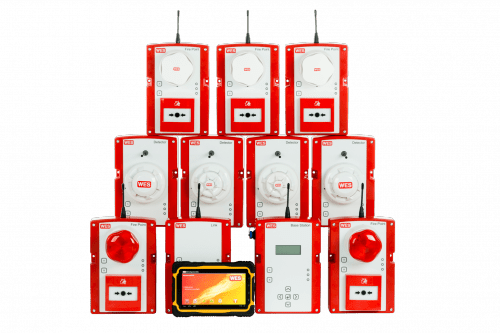Site of safety: Wireless emergency systems
Construction sites have many and varied hazards, although fire presents the greatest threat to life and loss of physical assets. Paul Henson, sales and marketing director at Ramtech Electronics, looks at how technology is helping in this area.

The fire at the University of Nottingham completely destroyed the partially completed £20m laboratory building
Traditionally, fire detection systems used on construction sites have been of the wired variety, which meant they had to be installed by electricians or specialist contractors. This could be a time consuming and costly process requiring numerous cables and fire points, all of which had to be moved frequently as construction progressed. Understandably, this resulted in companies being reluctant to install this kind of system.
That meant relying on manual emergency evacuation procedures, which could simply mean a nominated person sounding an alarm – ringing a bell after a fire had been detected, for example. This has a major weakness in that it relies on someone visually seeing the fire or smoke.
Worse still, if it occurs out of hours, like at the University of Nottingham recently, a fire can rage undetected for hours, with the end result a building that is completely destroyed and the loss of assets running into many hundreds of thousands of pounds.
Plug ‘n play
As a result of incidents such as this, construction companies are now embracing best practice and investing in wireless emergency systems. They are significantly easier to install, avoiding the need for specialist trades during set up and, because they are wireless, allow for easy repositioning of the fire points and heat detection units as the site progresses. Relatively inexpensive, they can save lives as well as significantly reducing consequential losses running to several million pounds. And, because they can provide pro-active fire detection, such a system can provide automatic cover even when your site isn’t populated, where call points rely on someone pressing the button. Had the fire at the University of Nottingham been detected earlier the complete loss of the building may have been avoided.
There are clear efficiency reasons why a wireless system demonstrates best practice, too. For example, advances in technology virtually eliminate false alarms because latest units are fitted with Category 1 wireless receivers, which are the most reliable currently available. A typical system comprises fire points and heat detection units or dustproof smoke detectors linked to a monitoring base station. In the event of a fire, the system triggers a high volume siren and a visual strobe light, alerting personnel to evacuate the site. At the same time, the base station allows the fire officer to instantly identify which unit has been activated, allowing fire and rescue teams to be deployed more effectively to the exact source of the incident.
 The Base Station provides SMS text alerts in the event of an alarm being activated, allowing personnel to keep tight control on fire safety when they are off site, providing 24 hour protection. To make reconfiguration easier, there are now system apps that can be used on any Android tablet, making the system fully mobile. It is possible to download an app via Google Play, which goes beyond simple configuration and enables much more extensive reporting on the system health.
The Base Station provides SMS text alerts in the event of an alarm being activated, allowing personnel to keep tight control on fire safety when they are off site, providing 24 hour protection. To make reconfiguration easier, there are now system apps that can be used on any Android tablet, making the system fully mobile. It is possible to download an app via Google Play, which goes beyond simple configuration and enables much more extensive reporting on the system health.
Conclusion
So, it can be seen that wireless emergency systems set out best practice when it comes to protecting personnel and assets from fires on construction sites. The fire at the University of Nottingham highlights how relying on manual intervention does not provide round the clock protection and in this case allowed the fire to get out of control and completely destroy the building. The consequences could have been far worse had personnel been on site.
Site of safety: Wireless emergency systems
Construction sites have many and varied hazards, although fire presents the greatest threat to life and loss of physical assets.
Safety & Health Practitioner
SHP - Health and Safety News, Legislation, PPE, CPD and Resources Related Topics
Honeywell guide sets out fire detection advice


